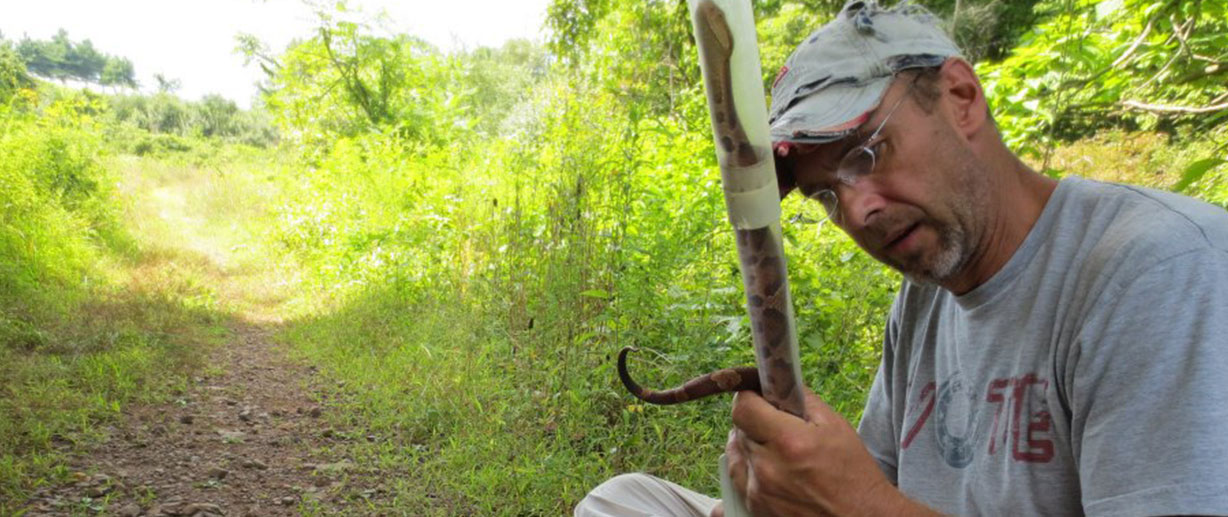SPARTANBURG, S.C. – For nearly 20 years, Dr. Charles F. (Chuck) Smith, associate professor of biology at Wofford College, and a team of other researchers studied copperhead snakes in Connecticut, looking at their genetics, behavior, reproduction and ecology. What they discovered about the impact of an unexpected drought on the snakes’ reproduction cycle, which the scientists have shared in a recent article in the prestigious journal Nature, has implications regarding climate change.
Each year beginning in 2001, the team returned to the Connecticut site to collect data on reproduction and life history of the copperhead population, and a five-year drought from 2012 through 2017 enabled them to capture the pre- and post-drought effects on the snakes.
The drought affected the study animals, their prey and the other animals that compete for those prey, says Smith, director of the Copperhead Institute in Spartanburg. The team did not specifically set out to study the effects of drought on copperheads, but “it sort of came to us,” he adds. “While we didn’t specifically address global warming per se, there is a connection to global warming in that droughts like the one experienced in Connecticut seem to be happening more frequently across the continental U.S.”
Studying the effects of climate change is problematic because the scale often is not manageable, notes Smith, who also represented the Chiricahua Desert Museum in Rodeo, New Mexico, on the research team. “So, most scientists who study changes in environment work at a local level and say, here’s what is happening here, and then project that on a larger scale.”
“In our population of copperheads, reproduction was normal prior to the drought and went rapidly to zero reproduction as the drought continued,” he continues. “Had the drought not subsided when it did, it is possible that the population could have been far more seriously compromised. The population is located in an urban area with no possibility of recruitment from surrounding areas, as they are cut off by highways and towns, so it is particularly vulnerable to a changing environment.”
The team was able to develop models that predict increased continental drying, Smith says. “While not pointing fingers at a cause, such as humans, it does suggest that droughts will be more common in the future. For copperheads, the declines in reproduction that we observed can then be expected to be more common, and if drought is more prolonged, may have serious consequences to the viability of their populations.”
Smith explains that copperheads are “capital breeders,” meaning that females must amass and store sufficient energy to reproduce. “So, if energy available in the form of prey is reduced (by drought), then reproduction suffers. Therefore, copperheads serve as a good model species of how a capital breeder confronts drought.”
This research involving copperheads is important, Smith says, because the snakes “are an important member of the ecosystem, as are all of the species that reside in (the ecosystem studied by the team). A useful analogy might be that of an airplane. You may lose one member of an ecosystem, or in the airplane analogy, you may lose a nut or bolt here or there, but the plane still flies. But as the losses start accumulating, losing more and more species … or nuts and bolts ... pretty soon the ecosystem ceases to function, or the plane ceases to fly.”
Recognizing that some people tend to “hate snakes,” and copperheads in particular, Smith notes, “All things are important in an ecosystem. Copperheads are part of the ecosystem of Connecticut and everywhere else they occur, as a predator, potential seed disperser, etc. But it wasn’t specifically copperheads that were important (in the research results), but rather that copperheads are capital breeders. This was an example of how a capital breeder confronts drought. We found that the effects are rapid and severe. Very quickly the population went from normal reproductive levels just prior to the start of the drought, to reduced reproduction after the drought began, to zero reproduction after several years of drought. So the impacts of a drying environment occur far quicker than we thought.”
Smith is happy to report that the team sampled the copperhead population in the year following normal precipitation after the drought ended and found that reproduction in the population rebounded – “Something we didn’t expect.”
Smith and the team are excited about the article in Nature, even after they published another one in Nature last August exploring the venom composition in copperheads produced by parthenogenesis. “This one is particularly exciting as it is a result of many years of field work. As biologists and scientists, we all aspire to get our work in journals such as Nature and Science, and we’re big proponents of the open format, which this journal is, where anyone can access the paper by simply typing in your name.”
- Gordan W. Schuett, Department of Biology and Neuroscience Institute, Georgia State University, Atlanta, Georgia
- Randall S. Reiserer, The Copperhead Institute; Chiricahua Desert Museum, Rodeo, New Mexico
- Catherine E. Dana, Illinois Natural History Survey, Prairie Research Institute, University of Illinois Urbana-Champaign, Champaign, Illinois; Department of Entomology, University of Illinois Urbana-Champaign, Urbana, Illinois
- Michael L. Collyer, Department of Biology, Chatham University, Pittsburgh, Pennsylvania
- Mark A. Davis, The Copperhead Institute; Illinois Natural History Survey, Prairie Research Institute, University of Illinois Urbana-Champaign, Champaign, Illinois
